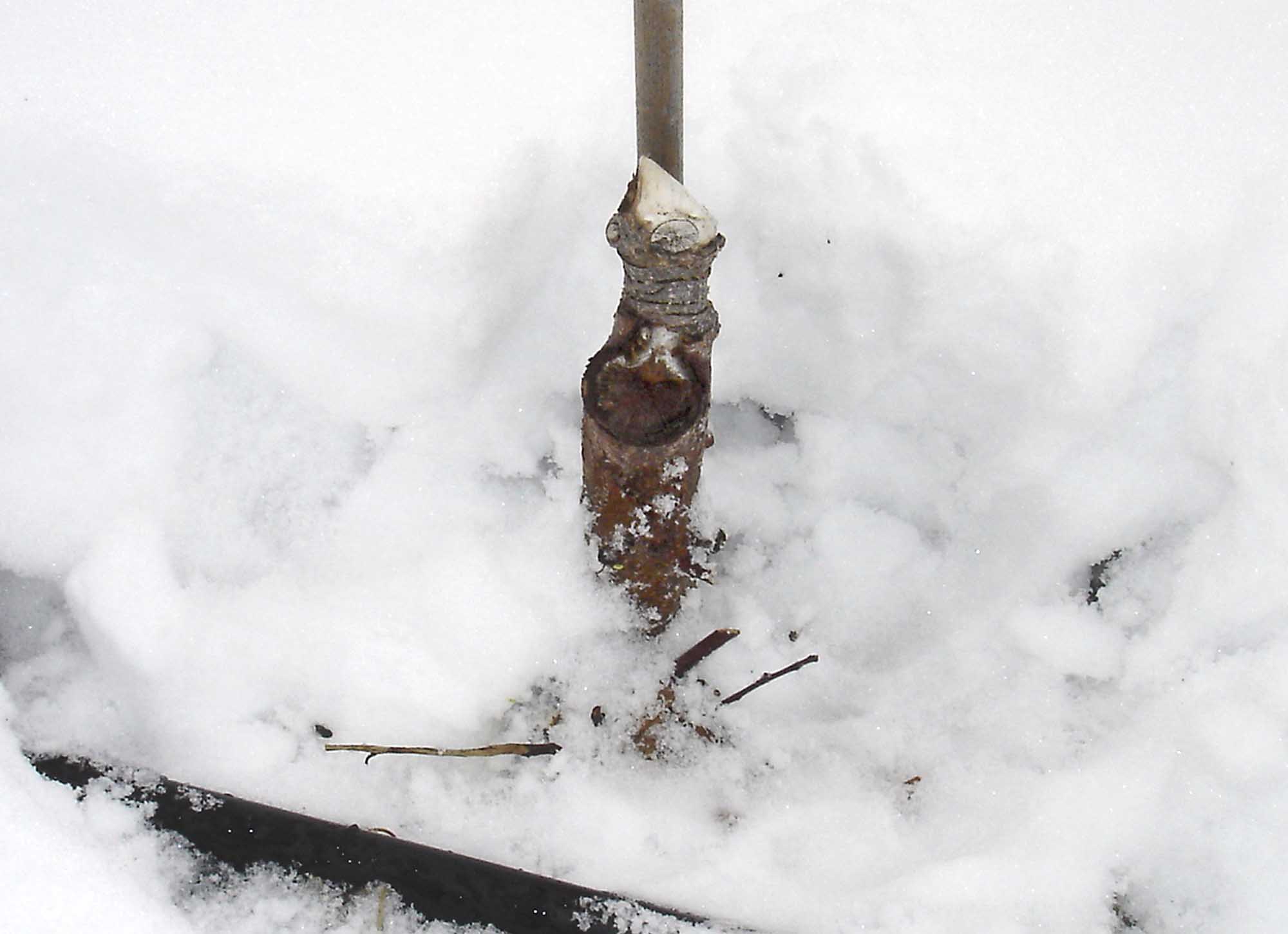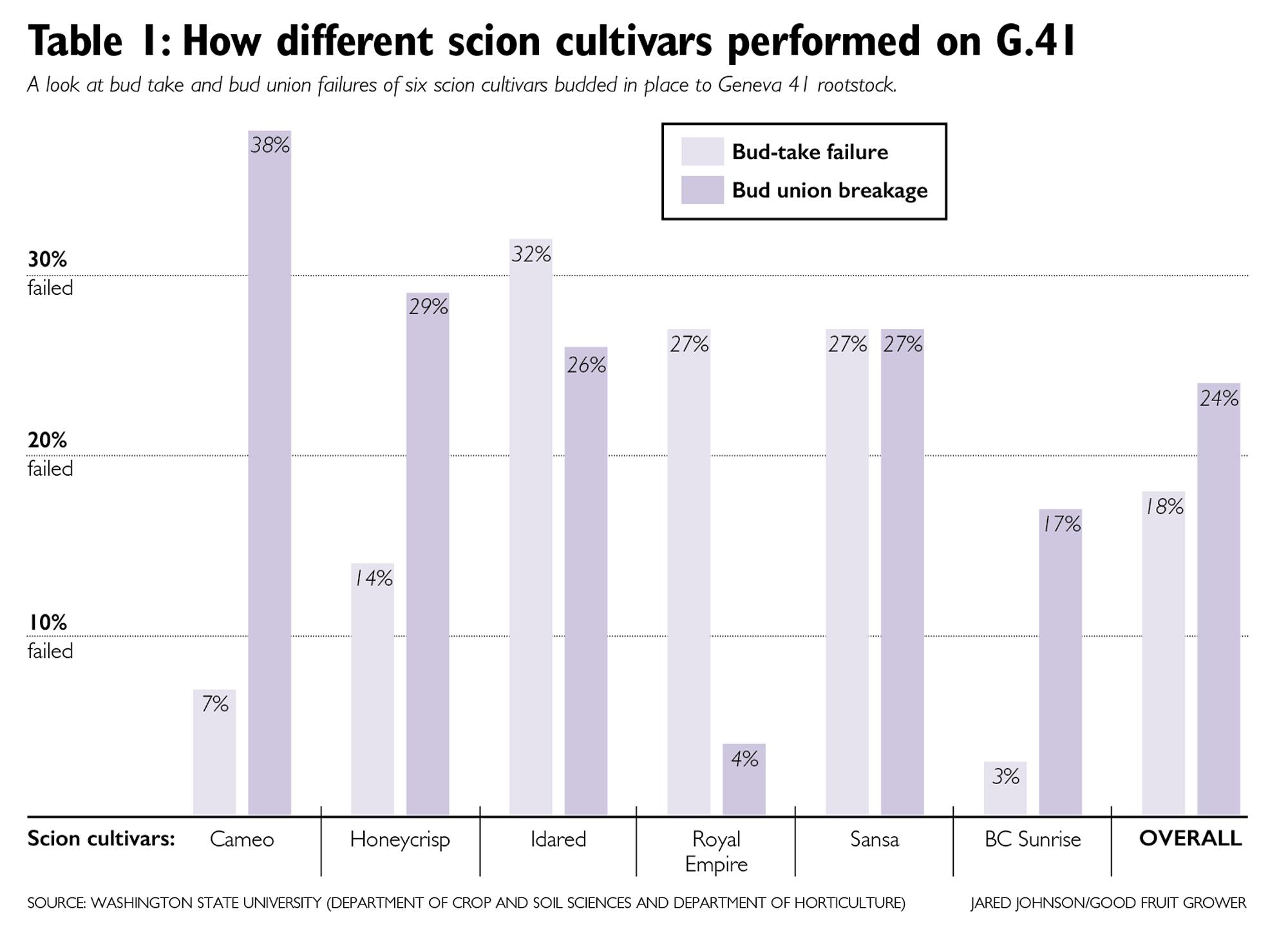
A Geneva 41, chip-budded with a Cameo in 2015, shows a black scar where the scion broke cleanly from the rootstock a year later. At the time of the failure, the tree was attached to a trellis. (Courtesy Stewart Higgins)
By Stewart Higgins, Brad Jaeckel, Francisco Gonzales and Lynne Carpenter-Boggs
Several reports have emerged of brittle graft unions on Geneva 41 (G.41) rootstocks. The prevailing opinion seems to be that the weak unions are primarily a concern for nurseries, where trees on G.41 have to be handled delicately to avoid breakage. Once in the orchard and properly supported on a well-maintained trellis, the danger of breakage is assumed to have passed.
Here, we report on our experience with trees on G.41 in the Eggert Family Organic Farm on the Washington State University campus in Pullman, Washington. We obtained G.41 from Copenhaven Farms Nursery, Gaston, Oregon, and planted them in our nursery, where they grew for one season. The next spring, the rootstocks were transplanted to the orchard where they were chip-budded in place to equal quantities of Cameo, Honeycrisp, Idared, Royal Empire, Sansa and BC Sunrise. All budwood was obtained from Van Well Nursery in Wenatchee, Washington, except BC Sunrise, which was obtained from Summerland Varieties Corp. in Summerland, British Columbia. Within-row tree spacing was 3.5 feet.
Our teaching/demonstration/research orchard consists of six tree rows on the contours of an east-facing hillside. Each scion cultivar is represented in each row by one five-tree plot, and the plots are located at random within the row. The experimental design is a randomized complete block with each row of the orchard being a block (replicate). The orchard therefore has 30 trees of each scion cultivar for a total of 180 trees. Trellis supports were installed prior to transplanting, but wires were strung afterward. Since we budded the trees in place, the finished trees were not subjected to handling as would be the case in a nursery. Budded trees were protected in 10-inch tall tree protectors until tall enough to be attached to the trellis at about 24 inches above ground. Trees were attached to the trellis using either hand tie tape or 4-inch ties.
Trees were budded in the spring of 2015. Bud take was relatively poor at 82 percent, but appeared to be comparable to the losses experienced by commercial nurseries. We were unable to determine the causes of the overall 18 percent budding failure, but the poor take was concentrated in Idared, Royal Empire and Sansa. Six trees were killed by rodents. Only trees that were initially assessed as having a successful bud and later found to have broken, were identified as a failed union due to breakage. Breakage was assessed through autumn 2017.

Table 1: How different scion cultivars performed on G.41. (Source: Washington State University (Department of Crop and Soil Sciences and Department of Horticulture). Graphic by Jared Johnson/Good Fruit Grower)
Results of breakage are presented in Table 1. Nearly one in four trees was lost due to a brittle bud union. About one-third of the graft failures occurred in 2017, the third field season after budding, in spite of trellis support. We analyzed the data statistically (Chi-squared analysis) to test whether the failed unions were more or less likely to occur in certain of the six scion cultivars. Although we lost 4 percent of Royal Empire, compared with 38 percent of Cameo, results of the statistical analysis provide insufficient evidence to claim that any of these scion cultivars was more or less susceptible to breakage than the others.
We leave it up to the reader to decide whether a 24 percent tree loss is acceptable. At high density, the space vacated by the loss of one tree can quickly be filled by the adjacent trees, so any loss of fruit production may be minimal, and possibly temporary. However, uneven spacing of leaders increases the difficulty of maintaining a homogenous fruiting wall. Opinions appear to be mixed regarding the likelihood of graft union failure as the trees age. Clearly, though, the recommendation (http://treefruit.wsu.edu/news/geneva-rootstock-performance-2016-rootstock-trial-update/) to properly engineer and maintain the trellis system supporting trees on G.41 is critical to success.
We hope to see the first crop on the remaining trees next year. It will be interesting to see whether we continue to lose trees due to a weak graft union. •
Higgins, Jaeckel and Carpenter-Boggs are with Washington State University’s Department of Crop and Soil Sciences. Gonzales is with the university’s Department of Horticulture.
References
https://goodfruit.com/can-science-strengthen-graft-unions/
http://www.ctl.cornell.edu/plants/GENEVA-Apple-Rootstocks-Comparison-Chart.pdf
http://treefruit.wsu.edu/news/geneva-rootstock-performance-2016-rootstock-trial-update/
Robinson, T., G. Fazio, B. Black and R. Parra. 2015. Cornell-Geneva apple rootstocks for weak growing scion cultivars. New York Fruit Quarterly, 23:21-24






Leave A Comment